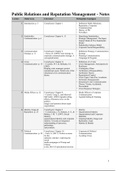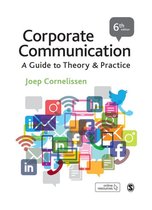Public Relations and Reputation Management - Notes
Lecture Onderwerp Literatuur Belangrijke begrippen
1 Introduction: p. 3 Cornelissen: Chapter 1 - Definition Public Relations;
Reputation; Corporate
Communication
- History of PR
- Nowadays
2 Stakeholder Cornelissen: Chapter 4, 13 - Identifying Stakeholders
Communication: p. 6 - Strategic Management: The Input-
Output Model & The Stakeholder
Model
- Stakeholder Salience Model
- Corporate Social Responsibility
3 Communication Cornelissen: Chapter 6 - Definition Strategy; Communication
Strategy: p. 11 + Steyn, B. (2004) From strategy to Strategy
corporate communication strategy: A - Planning Communication:
conceptualization. Campaign & Program
4 Crisis Cornelissen: Chapter 11 - Definition of a Crisis
Communication: p. 15 + Coombs, W.T. & Holladay, S.J. - Crisis Management: Anticipation &
(2002). Resilience
Helping crisis managers protect - Contingency Plans
reputational assets: Initial tests of the - Attribution of Responsibility;
situational crisis communication Attribution Theory
theory. - Reputational Capital
- Crisis Types: Faux-Pas; Accidents;
Terrorism; Transgression.
- Situational Crisis Communication
Theory: Victim; Accidental;
Preventable.
- Crisis Response Strategies
5 Media Effects: p. 22 Cornelissen: Chapter 8 - Media Effects in Corporate
+ Carroll, Craig E., and Maxwell Communication
McCombs. (2003) Agenda-setting - Agenda-Setting & Framing
effects of business news on the
public's
images and opinions about major
corporations.
6 Identity, Image & Cornelissen: Chapter 5 - Identity
Reputation: p. 25 + Cornelissen, J. P., Haslam, A. S., & - Organizational Identity
Balmer, J. M. T. (2007). Social - Organizational and Corporate
identity, Identities
organizational identity and corporate - Aligning Identity, Image and
identity: Towards an integrated Reputation: Gaps
understanding of processes, - Identity & Brands
patternings
and products.
7 Political Cornelissen: Chapter 10 - Corporate & Political
Communication: p. 29 + Enli, G. (2017). Twitter as arena Communication
for the - Avoiding Crises
authentic outsider: exploring the
social
media campaigns of Trump and
Clinton
in the 2016 US presidential election.
1
,Lecture Onderwerp Literatuur Belangrijke begrippen
8 CSR Communication: Du, S., Bhattacharya, C. B., & Sen, - Definition CSR
p. 33 S. - Antecedents + Outcomes
(2010). Maximizing business returns - CSR Promotional Communication
to Dilemma
Corporate Social Responsibility - Attribution of CSR Motives
(CSR): - CSR Fit
The role of CSR communication. - Message Channels CSR
Maignan, I., & Ferrell, O. C. (2004).
Corporate Social Responsibility and
marketing: An integrative
framework.
9 Social Media: p. 40 Van Noort, G., Willemse, L., - PR and Social Network Sites
Kerkhof, P. - Social Media Audiences
& Verhoeven, J. (2014). Webcare as - Audience Engagement
an - PR Online
integrative tool for customer care, - Empowered Consumers
reputation management, and online - Webcare
marketing: A literature review. - Online Presence of an Organization
Beukeboom, C. J., Kerkhof, P., & de
Vries, M. (2015). Does a virtual like
cause actual liking?: How following
a
brand’s Facebook updates enhances
brand evaluations and purchase
intention.
10 Internal Cornelissen: Chapter 9, 12 - Employee Communication
Communication: p. 46 - Organizational Identification
- Creating an effective
Communication Climate
- Organizational Silence
Consequences
- Leadership
- Change Management
11 Globalization: p. 53 Verčič, - Definition Globalization
D., Zerfass, A., & Wiesenberg, - Five Features of a Global Brand:
M. (2015). Global public relations Consistent Message; Organizational
and support of brand image; Control and
communication management: A standardization; Entrance in new
European perspective. markets; Add value to new products
- Challenges of Globalization
Melewar, T. C., & McCann, C. D. - International PR Functions
(2004). Facets of the global corporate - Perspetives on Diversity
brand.
2
,Lecture 1: Introduction PRRM
Public + Relations
Public = audience
Relations = connections
- Management of Communication of the Organization, e.g. negotiation on points of view &
bridging interests (Grunig)
- The development of relationships to help communicate about an organization, an issue, person
or a product (Gordon)
- Management of a mutual understanding between an organization and its publics (Cutlip)
Public Relations defines the function or activity that aims to establish and protect the reputation of
a company or brand, and to create mutual understanding between the organization and the segments
of the public with whom it needs to communicate
Mutual understanding = a certain degree of consistency between how organization wishes to
be seen, and how its actually seen by the public
Reputation
- Is the overall assessment of an organization by its stakeholders
- It represents the emotional reaction of costumers, investors, employees and public
- It encompasses dimensions, such as product quality, innovation, investment value, people
management and responsibility
Corporate communication is a management function that offers a framework for the effective
coordination of all internal and external communication with the overall purpose of establishing and
maintaining favorable reputations with stakeholder groups upon which the organization is
dependent
3
, History of PR
Public Relations have always existed somewhat informally: they have a role in capturing the
attention of the public and mobilizing citizens. It is not a surprise that some of the oldest PR
material we have today is connected to political propaganda, or recruitment for wars.
In the early 1900’s, with the Industrial Revolution, and the development of advertisement as a
structured concept, Public Relations became more formalized.
In 1900, the Publicity Bureau is founded in Boston. Meanwhile, similar institutions begin to appear
in the UK.
Edward Bernays is considered to be the founding father of Public Relations as a discipline, he was
the nephew of Freud and deeply influenced by his theories about the subconscious. He introduced
the concept of the focus group and worked with tobacco brands and other controversial products.
PR is not all about the product that is communicated, but it’s really about the way such
communications are framed and the way the public reacts to the content.
Public Relations in the 1980’s
- Restructuring trend: all activities within an organization evaluated on the basis of what they
contribute to the organization
- Communication professionals are consolidated in PR departments and procedures are established
for the whole organization
- Advantage: Public Relations start being recognized as a function the whole organization
benefits from
- Disadvantage: No consideration is given for the role of stakeholders
Public Relations in the 1990’s
- Strategic Positioning: organizations use PR as a way to achieve a competitive corporate identity
- Communication professionals have the role to shape an organization’s brand, which can be
conveniently ‘positioned’ within the minds of stakeholders
- Advantage: Public Relations become a crucial strategic tool for organizations to be more
profitable
4





